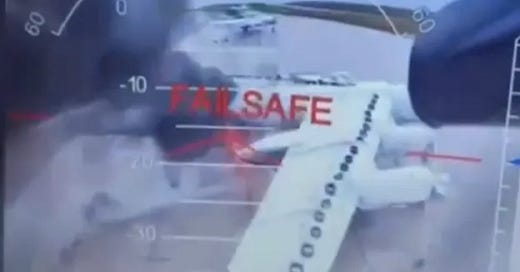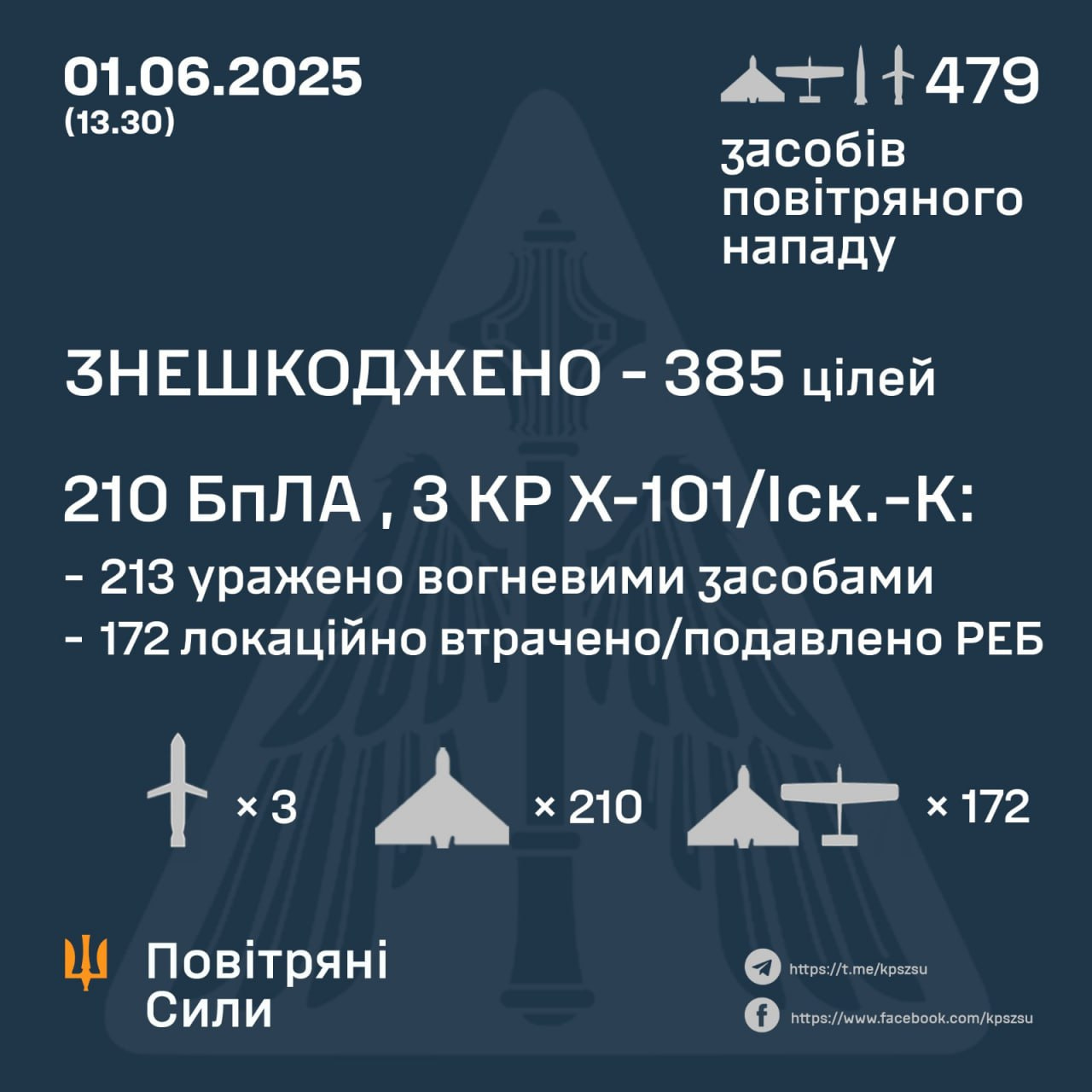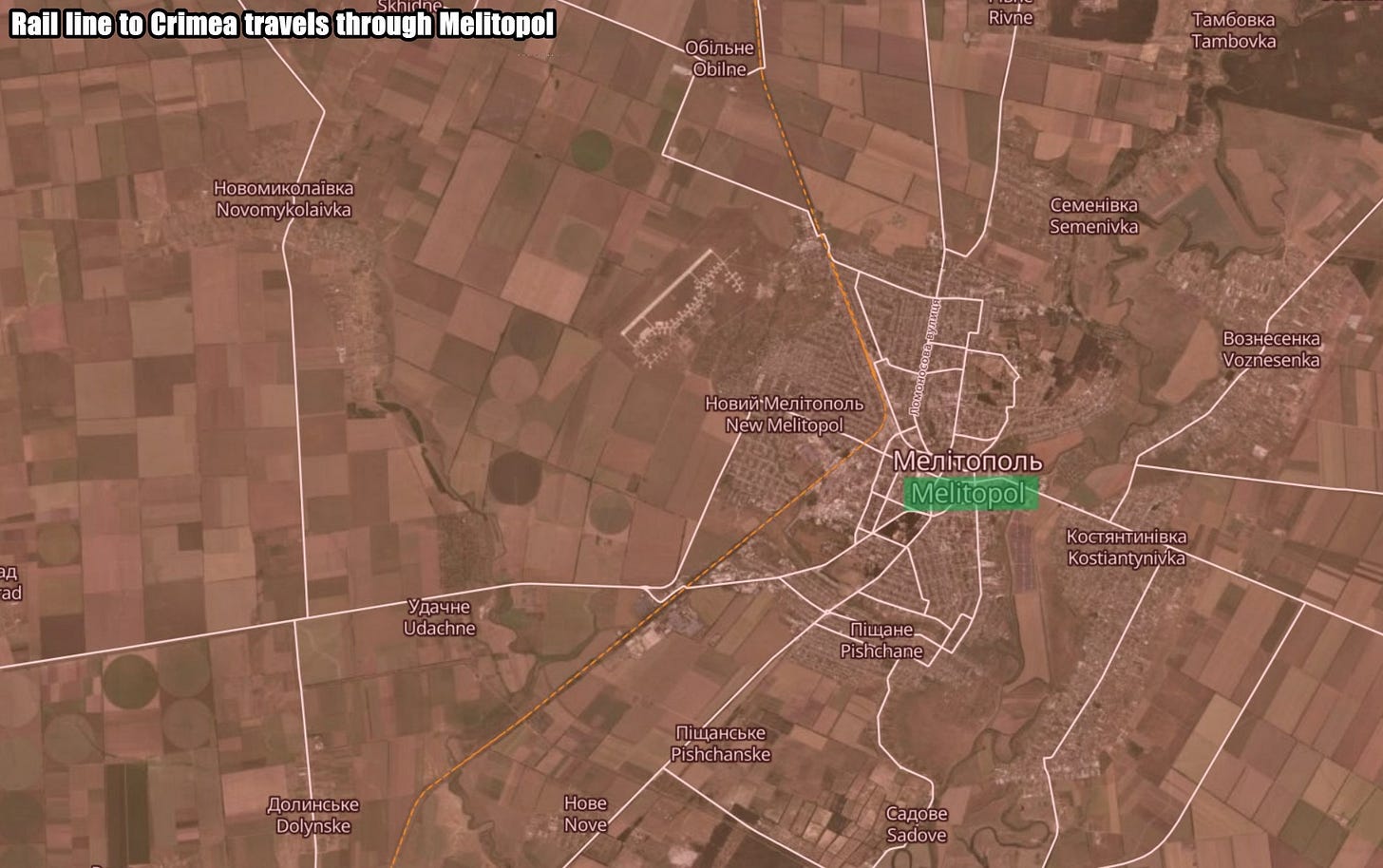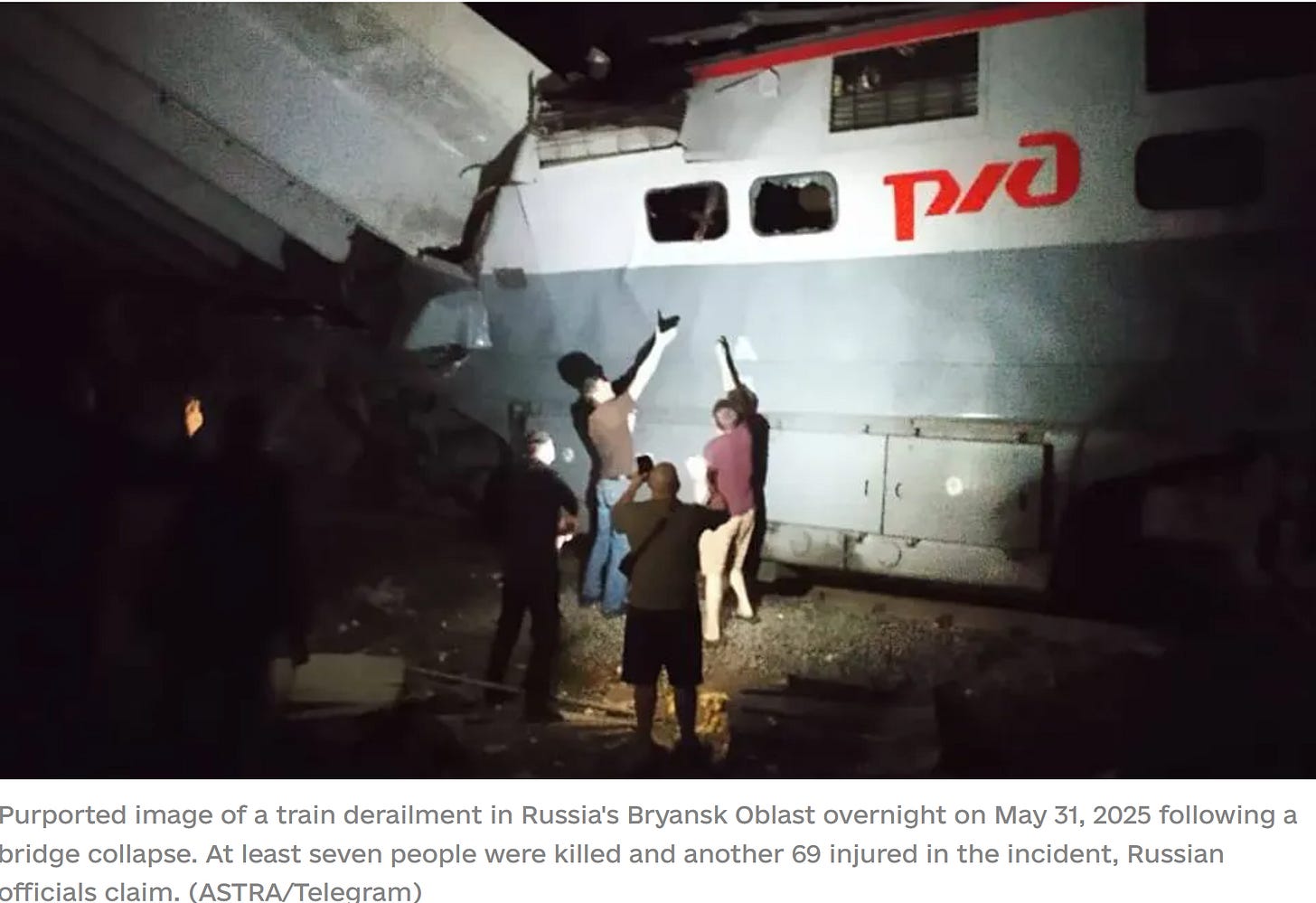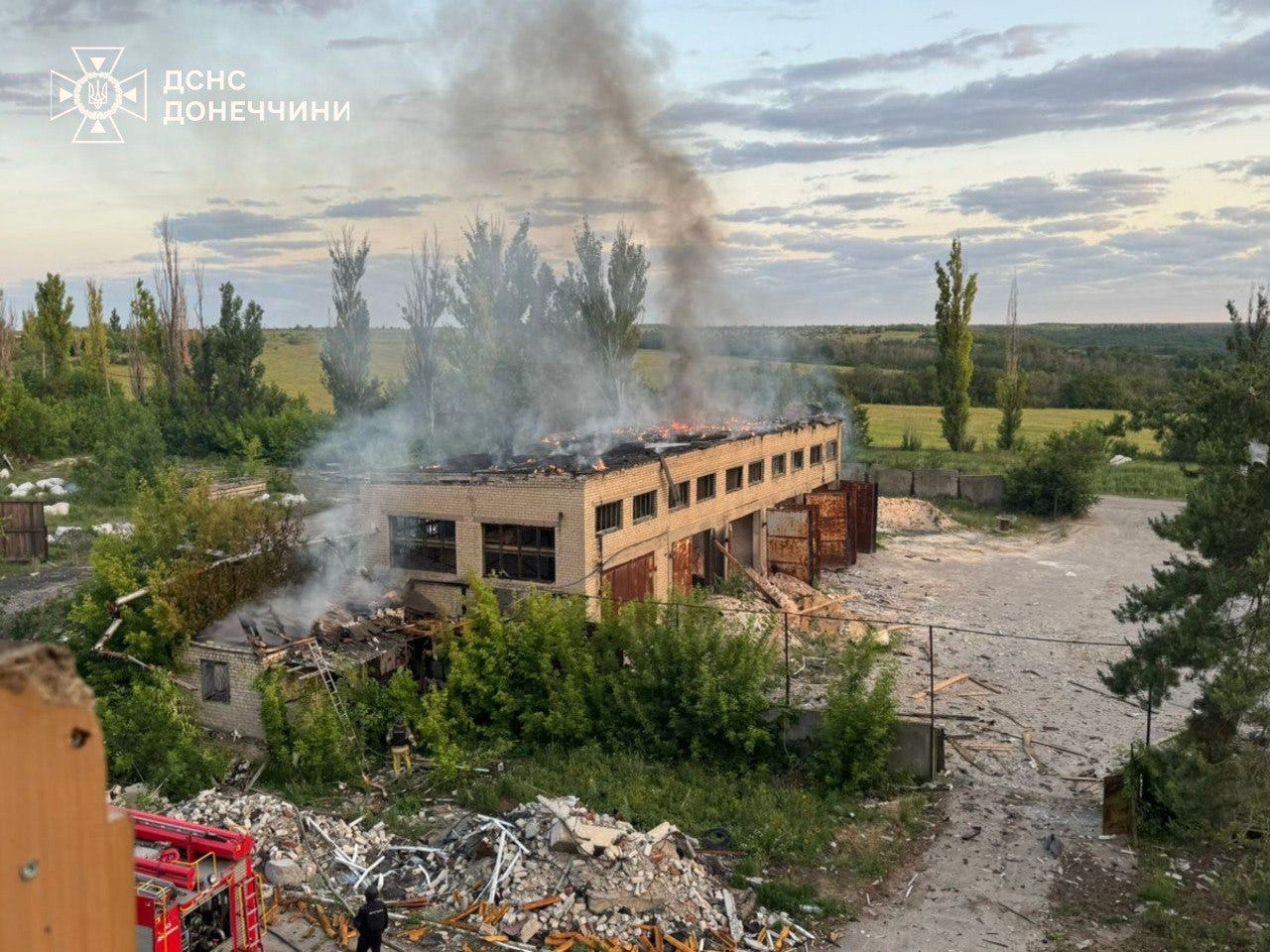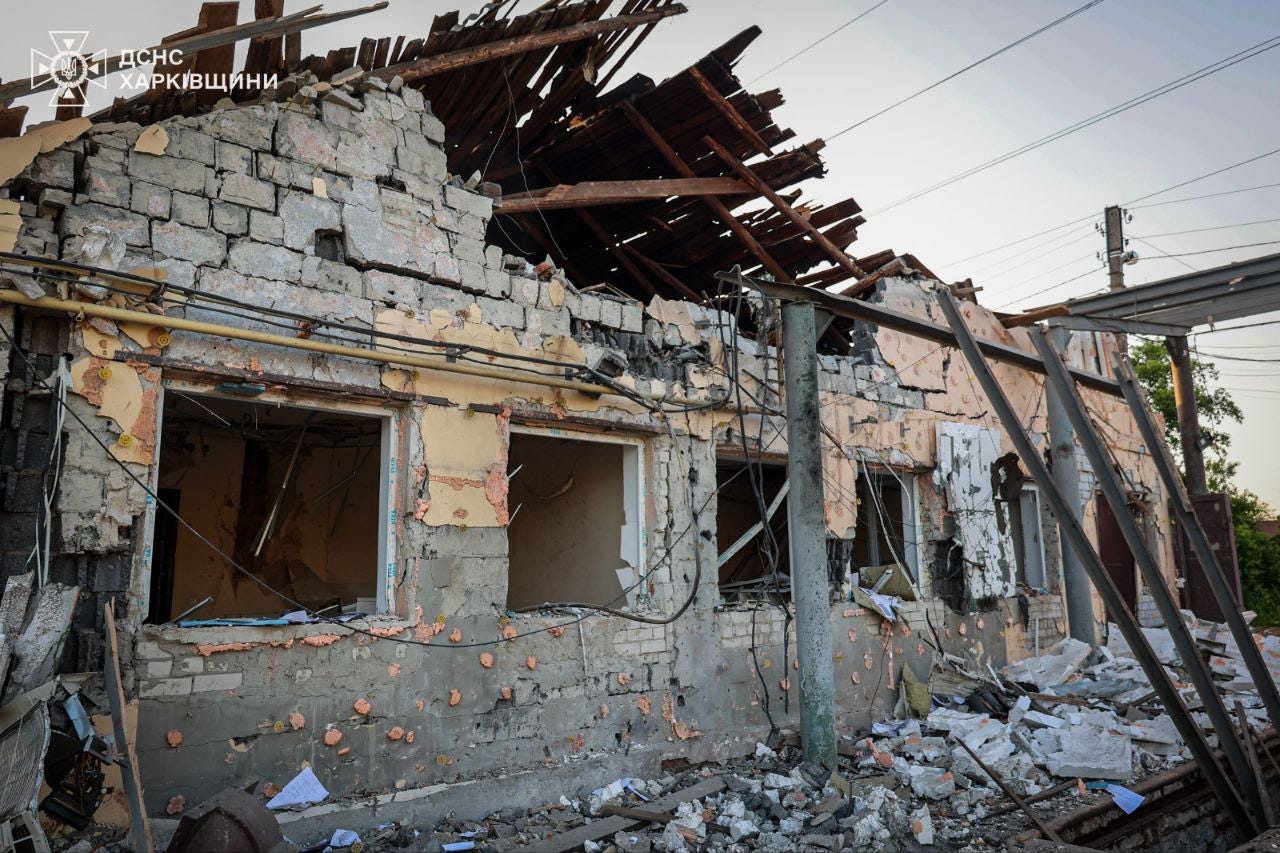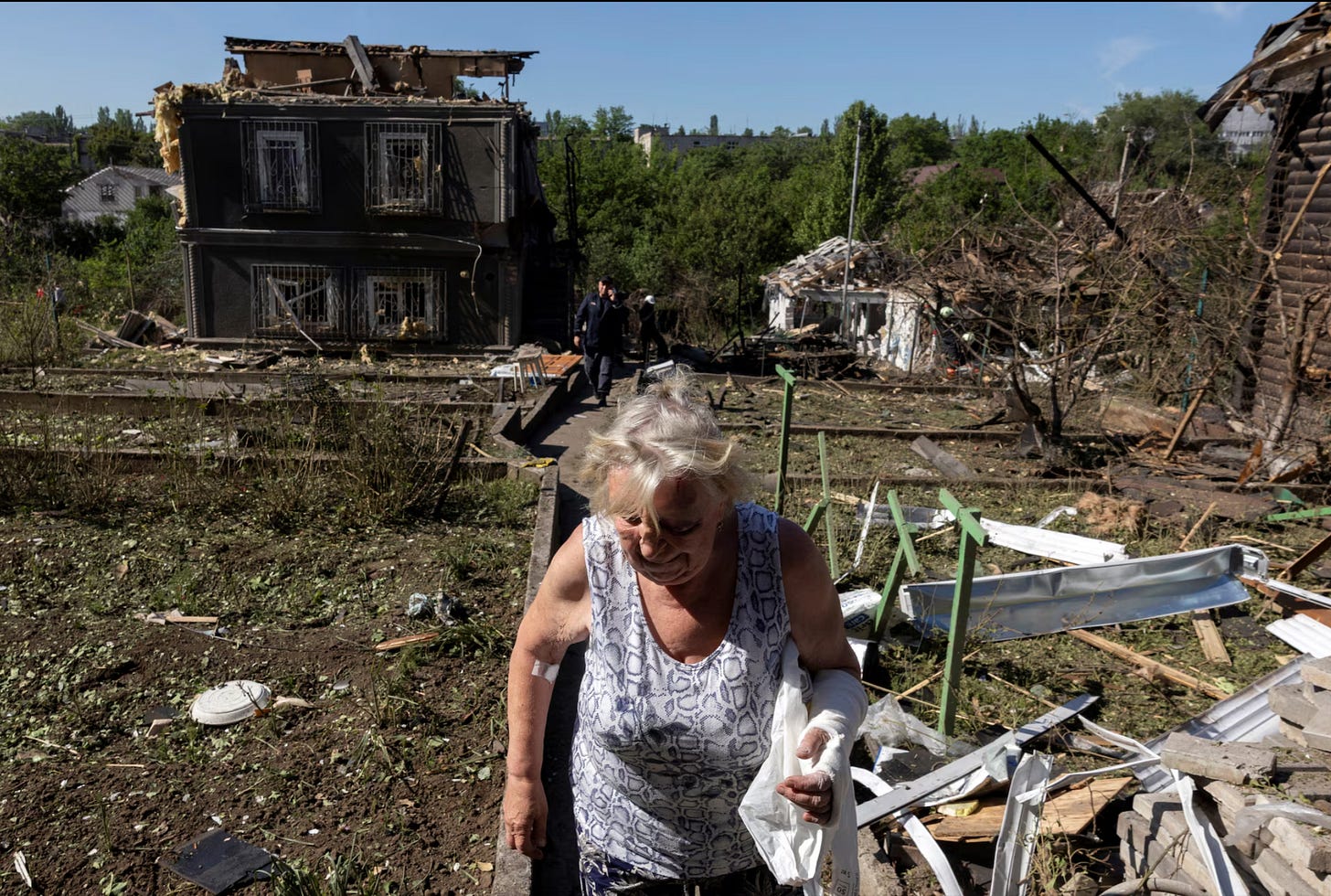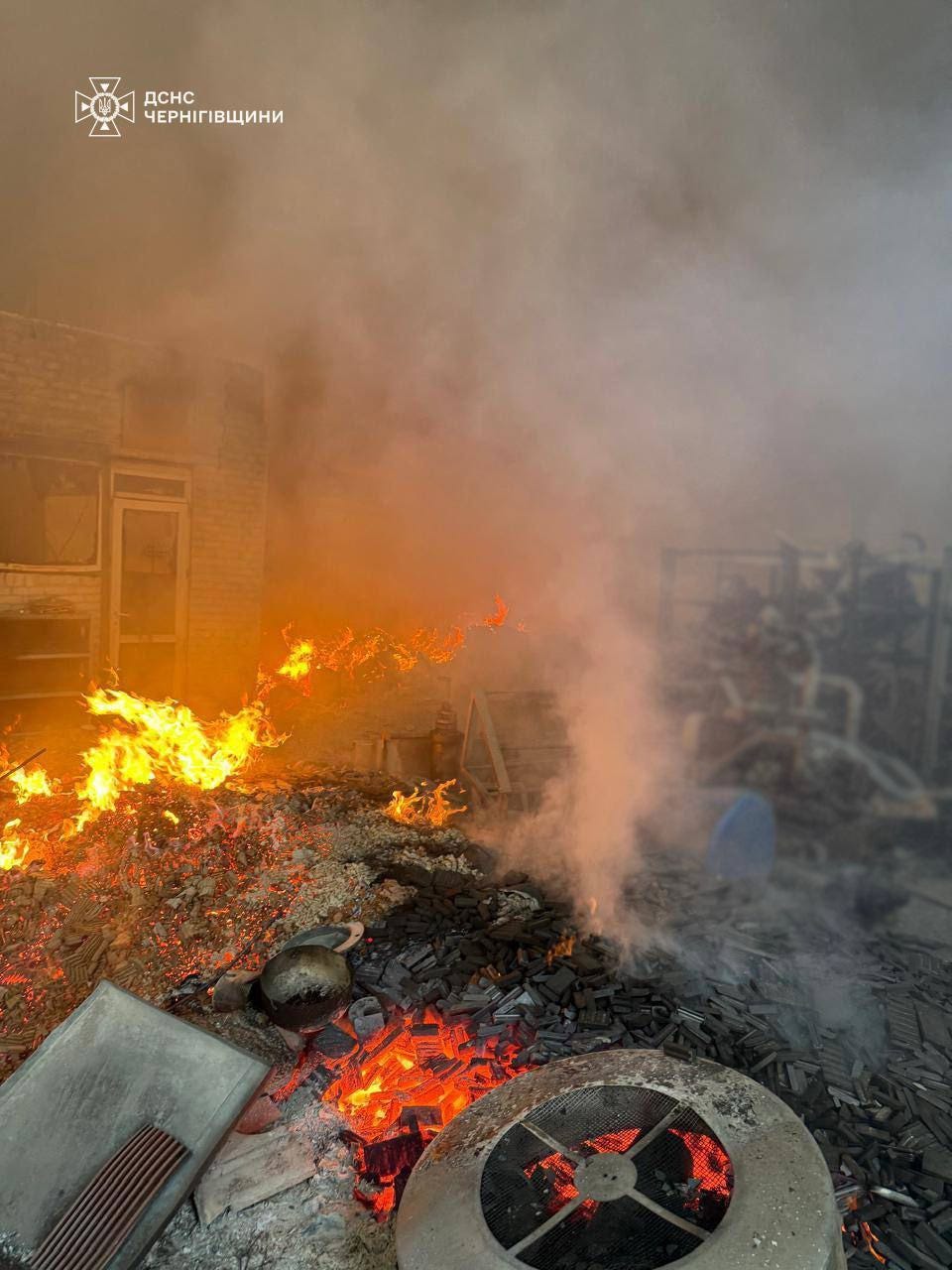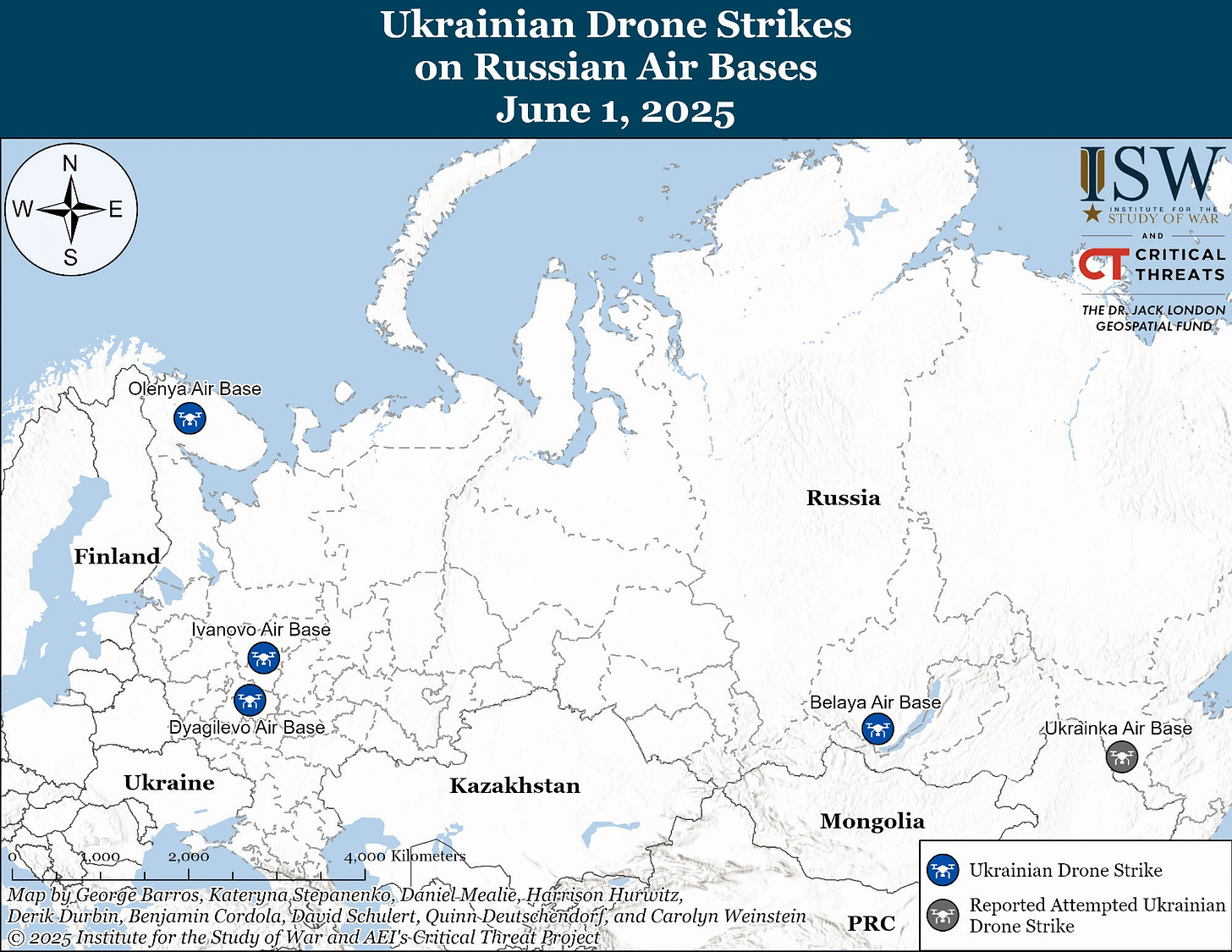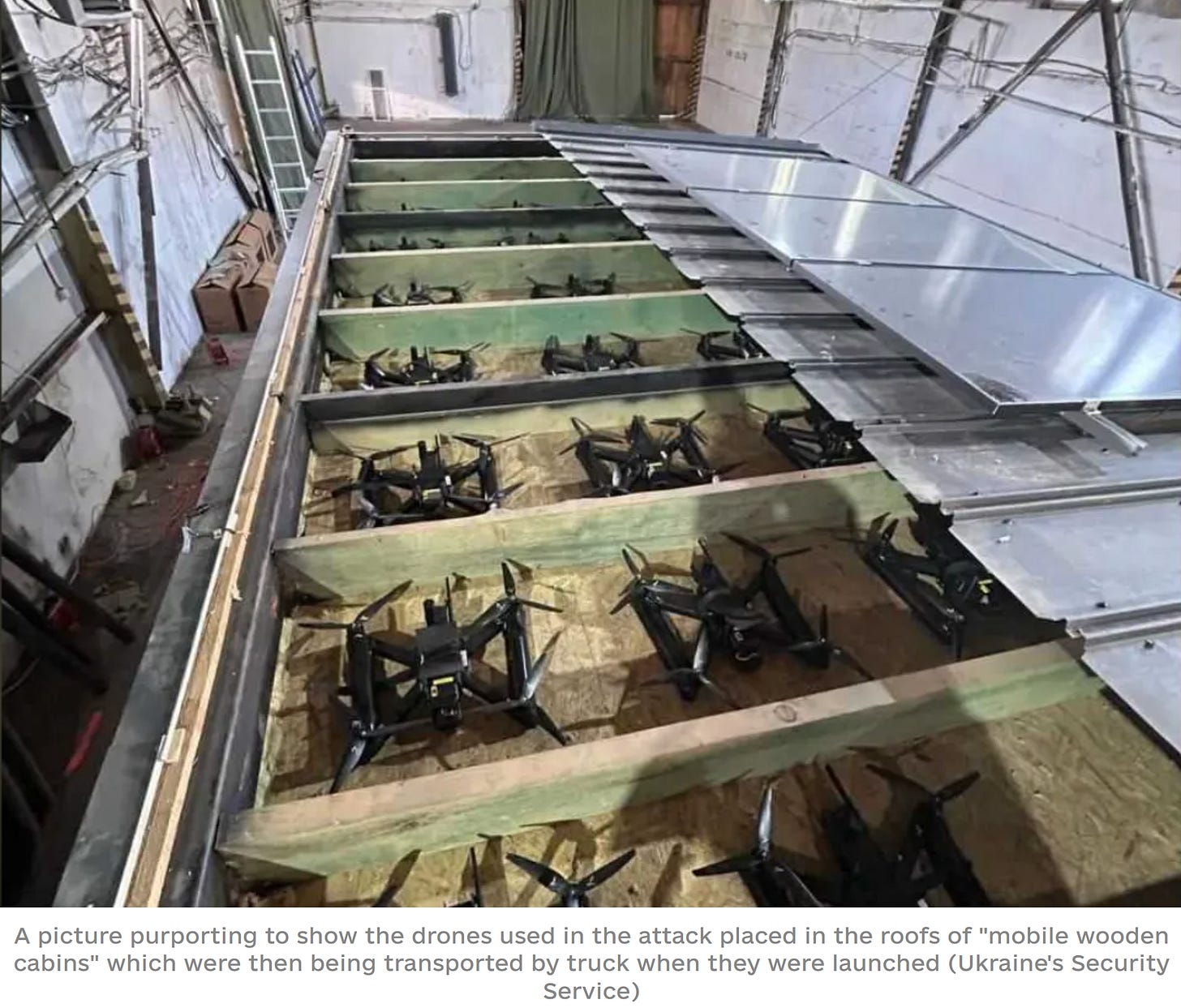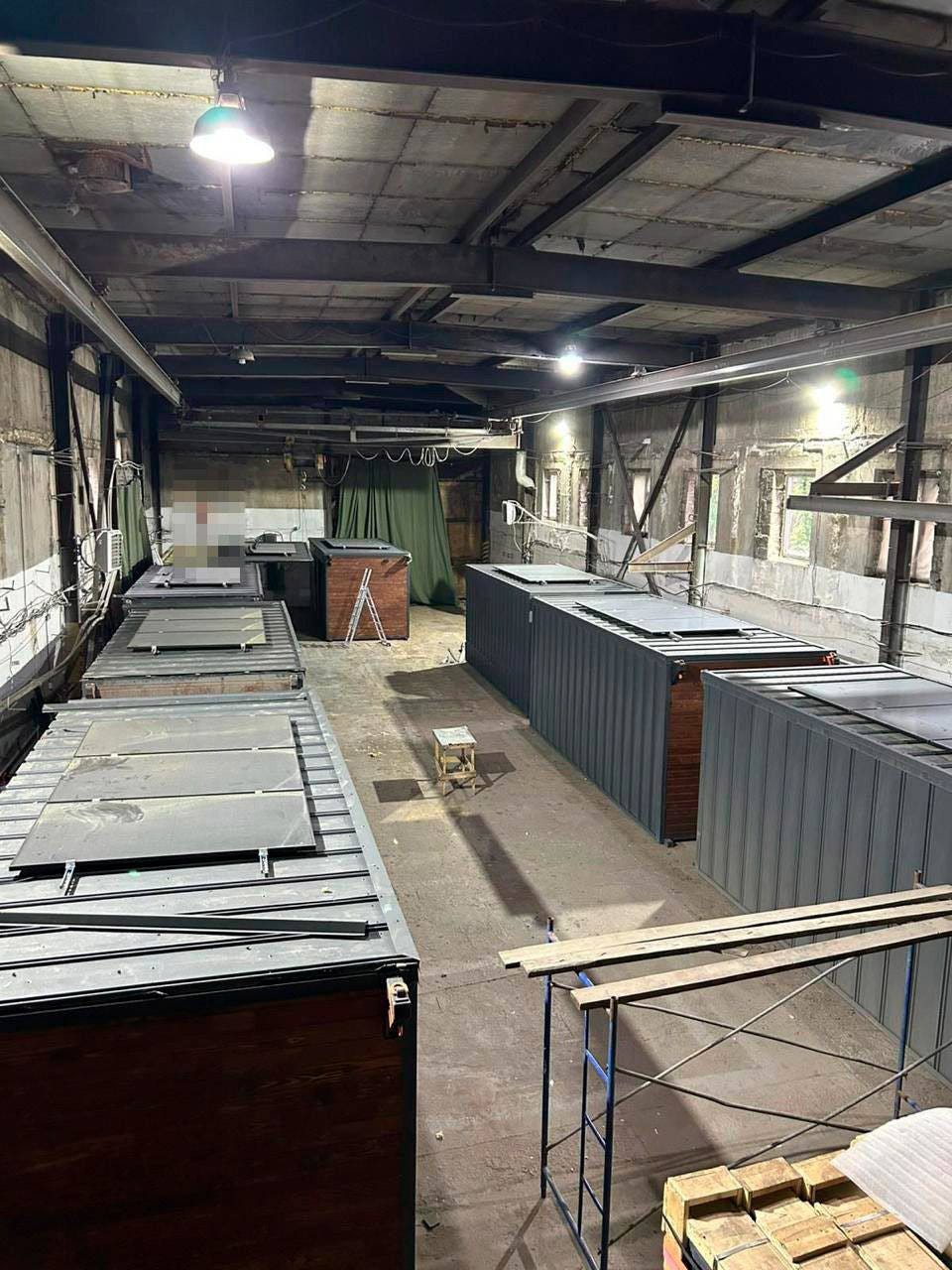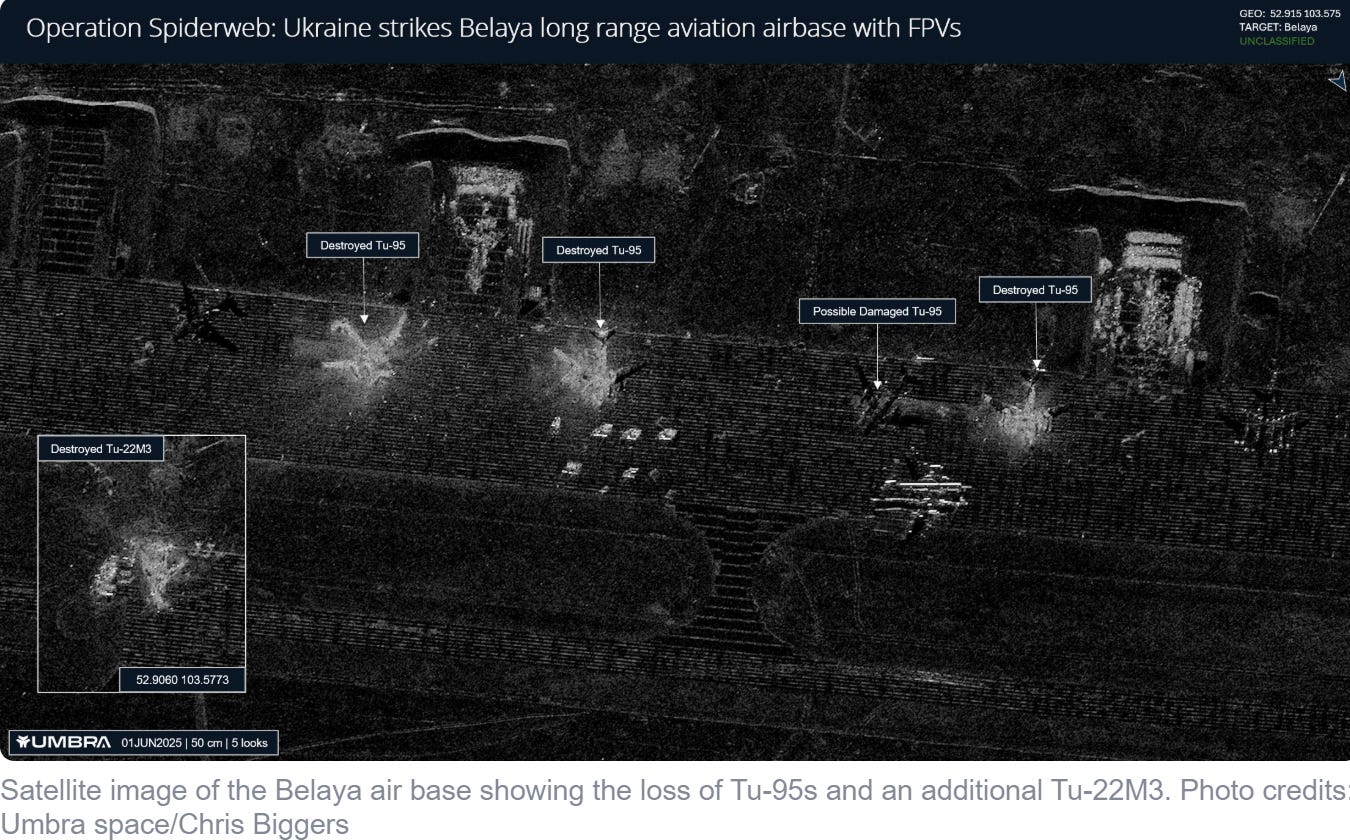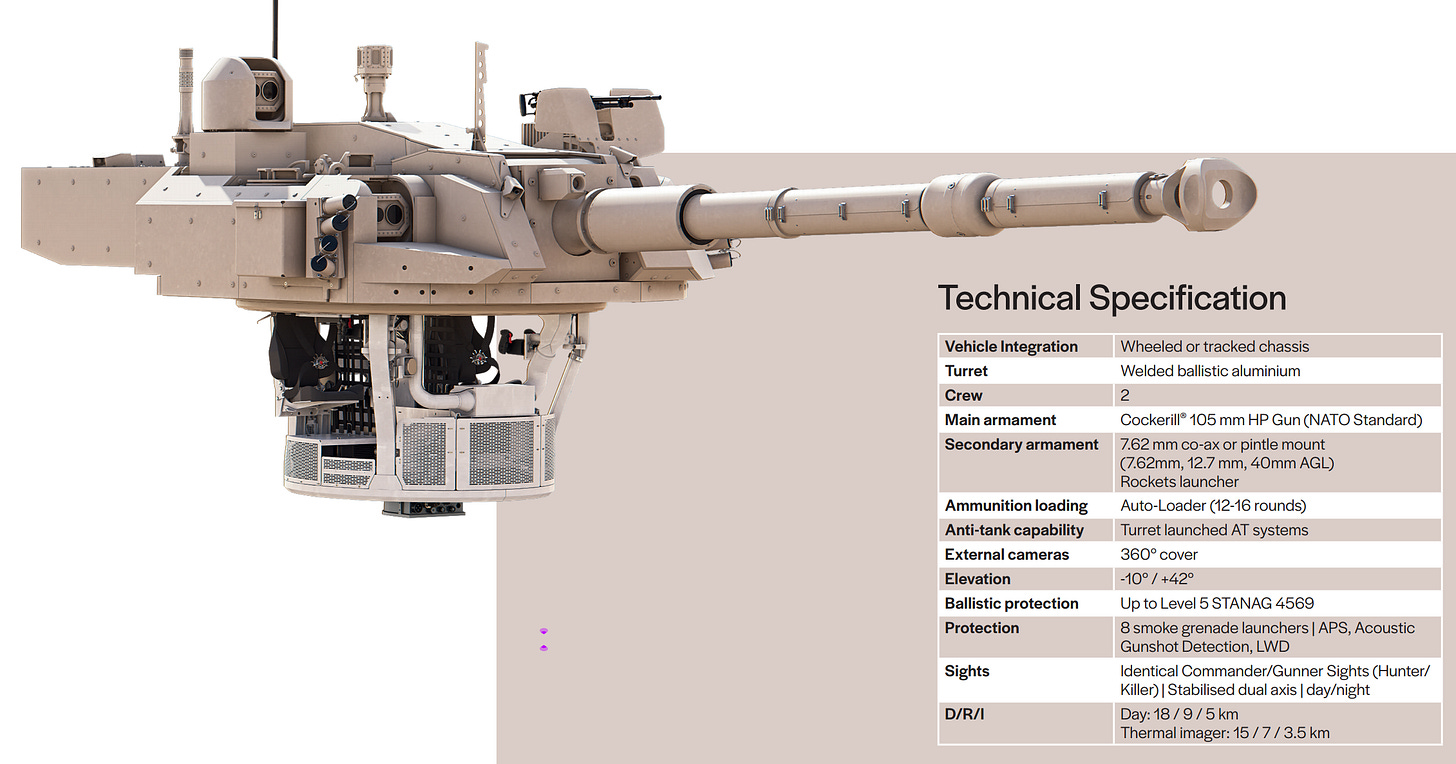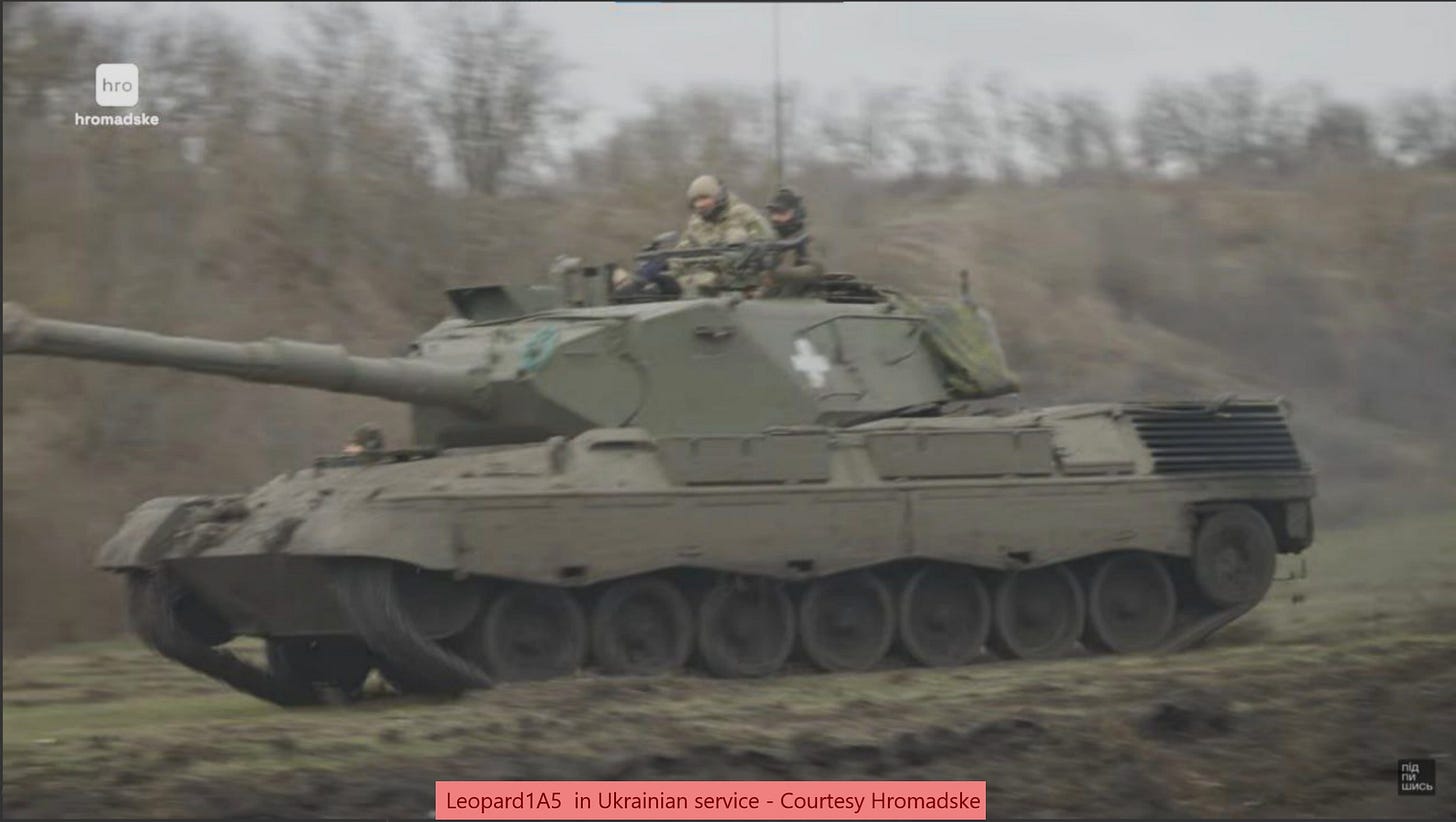Slava Ukraini! In early 2022 I began a Telegram channel aggregating news from a number of sources daily on the war in Ukraine. In June 2023 I began providing a daily draft for the Ukraine War Brief Podcast collecting news from over 70 sources daily, which formed the basis of the script. While the Podcast no longer exists I have continued to make this Brief available for my followers here on Substack for those who wish to keep up with the news from the war.
If you find the Brief informative I would appreciate it if you shared it with others.
All the latest news on the Russo-Ukraine War 6 days per week
ALONG THE CONTACT LINE
GSAFU Morning Report
For: Jun 2, 2025
The General Staff of the Armed Forces of Ukraine in its Operational Information update at 08:00 on Jun 2 stated that day 1195 of the full-scale invasion of the Russian Federation against Ukraine had begun.
The situation on the line of combat remains tense in some sectors. Ukrainian defenders continue to actively counteract the Russian aggressor, causing them significant losses in personnel, equipment and technology. Exhausting the enemy along the entire front line and continuing to disrupt the plans of Russian occupiers to advance deeper into the territory of Ukraine.
During the past two days, 312 combat engagements took place.
Over the past 48 hours, the enemy carried out 7 missile strikes, 145 air strikes, used 6,689 attack drones and fired approximately 11,900 artillery shells across the positions of Ukrainian forces and civilians.
Air Force Daily Report
Air defence forces destroyed more than 4,000 enemy air targets in May.
The Ukrainian Air Force reported on Jun 1 that In May 2025, the Defence Forces' air defence destroyed 4,051 air targets.
In particular, they were destroyed:
46 X-101/X-55SM cruise missiles;
9 Iskander-M/KN-23 ballistic missiles;
14 Kalibr cruise missiles;
5 X-59/69 guided missiles;
1,892 Shahed strike UAVs;
731 reconnaissance UAVs;
1354 UAVs of other types.
In May, the Air Forces carried out over 769 sorties, in particular:
about 442 - for fighter air cover;
More than 228 were used for fire support and air support of troops.
"In May 2025, the aviation of the Ukrainian Defence Forces destroyed 365 air targets, hit command posts, logistics facilities, as well as places of concentration of enemy manpower and military equipment,"
385 AIR ATTACK VEHICLES DISABLED
➖➖➖➖➖➖➖➖➖
On the night of Jun 1 (from 7:30 p.m. on May 31), the enemy attacked with 479 air attack vehicles:
- 472 Shahed attack UAVs and simulator drones of various types from the following directions: Millerovo, Shatalovo, Kursk, Orel, Bryansk, Primorsko-Akhtarsk – Russia;
- 3 Iskander-M/KN-23 ballistic missiles from Kursk and Voronezh regions – Russia;
- 4 air- and ground-based cruise missiles Kh-101, Iskander-K.
The main areas of the air strike are Kharkiv, Sumy, Zhytomyr, Odesa, Donetsk, Dnipropetrovsk and Zaporizhia regions.
The air attack was repelled by aviation, anti-aircraft missile troops, electronic warfare and unmanned systems units, and mobile fire groups of the Defense Forces of Ukraine.
According to preliminary data, as of 13:30, air defenses neutralized 385 enemy air attack vehicles: 210 enemy Shahed UAVs (other types of drones) and 3 Kh-101/Iskander-K cruise missiles in the east, south, north, west and center of the country. 213 were shot down by fire weapons, 172 were lost/suppressed by electronic warfare.
Enemy airstrikes were recorded in 18 locations.
52 AIR ATTACK VEHICLES DISABLED
➖➖➖➖➖➖➖➖➖
On the night of June 2 (from 9:30 p.m. on June 1), the enemy attacked with 84 air attack vehicles:
- 80 Shahed attack UAVs and simulator drones of various types from the following directions: Kursk, Orel, Bryansk, Primorsko-Akhtarsk - Russia;
- 3 Iskander-M/KN-23 ballistic missiles from Voronezh Oblast – Russia;
- 1 Iskander-K cruise missile from Bryansk region - Russia.
The main areas of the air strike are Kharkiv, Chernihiv, Donetsk and Kherson regions.
The air attack was repelled by aviation, anti-aircraft missile troops, electronic warfare and unmanned systems units, and mobile fire groups of the Defense Forces of Ukraine.
According to preliminary data, as of 08:30, air defenses neutralized 52 enemy air attack vehicles in the east, south, and north of the country: 15 enemy Shahed UAVs (other types of drones) were shot down by fire weapons, 37 were lost/suppressed by electronic warfare.
Enemy airstrikes were recorded in 12 locations.
Combat Operations in the Russian Federation
There have been no major changes to the combat environment since our last report.
The Khortytsia operational-strategic group
(Responsible for the northeastern part of Ukraine. )
Sumy Sector: Russian forces recently advanced in Sumy Oblast.
Geolocated footage published on June 1 indicates that Russian forces recently advanced southeast of Kostyantynivka (north of Sumy City).
Toretsk Sector: Russian forces recently advanced in the Toretsk direction.
Geolocated footage published on May 31 and June 1 shows Russian servicemembers holding Russian flags in northern Dyliivka (north of Toretsk) and central Zorya (west of Toretsk), indicating that Russian forces recently seized these settlements.
The Tavria operational-strategic group
(Responsible for the central-eastern and southeastern part of Ukraine.)
There have been no major changes to the combat environment since our last report.
The Odesa operational-strategic group
(Responsible for Kherson, Qırım, (also known as Crimea) and the Black Sea.)
There have been no major changes to the combat environment since our last report.
TEMPORARILY OCCUPIED TERRITORIES
Russian military freight train blown up enroute to Crimea
A Russian military train carrying fuel and food was blown up overnight on June 1 near Melitopol, according to Ukraine's military intelligence (HUR), the Kyiv Independent reports.
"The Muscovites' key logistical artery on the occupied territory of Zaporizhzhia Oblast and Crimea has been destroyed," HUR's statement said.
The agency stopped short of claiming responsibility for blowing up the Russian train station in southern Zaporizhzhia Oblast, but said "the fight against the military logistics of the Russian occupiers continues."
HUR's statement further noted heightened Russian searches and stricter checkpoints in the region as Russian forces seek to find those responsible.
It was a bad night for Russian railways. A train derailed in Bryansk Oblast, which borders Ukraine to the North, after a road bridge collapsed, killing at least seven people and injuring 69 others.
Preliminary reports suggest that explosions were heard in the Vygonichsky district of Bryansk Oblast ahead of the impact, and Moscow Railways, a subsidiary of state-run Russian Railways, claimed that the bridge collapsed due to the "unlawful interference in transport operations."
No further information was provided as to the cause of the bridge collapse, and the full extent of the damage was not immediately clear.
And the Ukrainian partisan group Atesh claimed to have sabotaged a railway in occupied Donetsk Oblast.
THE HOME FRONT
Russian Missile Strike Hits Ukrainian Army Training Site, Killing 12.
Russia launched a missile strike on a location used by a training unit of Ukraine’s Ground Forces, killing 12 soldiers and injuring more than 60, Militarnyi reported citing Ukraine’s Ground Forces Command on Sunday.
The attack took place on June 1, targeting an area where personnel were stationed.
Ground Forces Command stated that an emergency commission had been established to investigate the circumstances of the strike.
The press service emphasized that no mass formations or gatherings of troops had been taking place at the time of the strike. It emphasized that most personnel were in shelters following the announcement of an air raid alert.
According to the military, all the injured are receiving comprehensive and qualified medical care.
The command and staff of Operational Command East are cooperating fully with the investigation, any officials found responsible for negligence will be held to account.
Security measures have been stepped up at military sites in rear areas following a wave of Russian missile and air strikes targeting facilities far from the front line.
The incident follows a similar Russian strike in March on a Ukrainian training site in the Cherkasy region, which killed around 40 soldiers and injured more than 100.
In that case, Colonel General Oleksandr Syrskyi suspended the training center and military unit commanders pending an investigation.
Russia kills 9, injures 49 civilians across Ukraine overnight.
Russian attacks across Ukraine killed at least nine civilians and injured at least 49, including children, over the past day, the Kyiv Independent reported citing regional authorities on June 2.
The attacks come as Ukrainian and Russian officials are scheduled to hold a second round of peace talks in Istanbul later during the day. They also follow a mass Ukrainian drone strike that allegedly destroyed or damaged one-third of Russia's strategic aviation fleet on June 2.
In Dnipropetrovsk Oblast, Russian artillery and drone attacks against the Nikopol district injured three men aged 51, 68, and 72, all of whom were hospitalized, Governor Serhii Lysak reported. A medical facility, a fire department, and a shop were reportedly damaged.
Russian attacks against Donetsk Oblast killed one person and injured three in Kostiantynivka, according to Governor Vadym Filashkin. Another civilian was injured by a Russian strike in Hryshyne.
Russia attacked Kharkiv Oblast heavily with drones, a ballistic missile, and other weaponry. Twelve people, including two children, were injured in the region, including six in Kharkiv, Governor Oleh Syniehubov said.
In Kherson Oblast, three people were killed and 19 injured, including two children, Governor Oleksandr Prokudin reported. Three high-rise buildings, seven houses, warehouses, and other properties were damaged.
In Mykolaiv Oblast, a 65-year-old man and a 60-year-old woman were hospitalized following a Russian drone attack, Governor Vitalii Kim reported.
Russian attacks across Zaporizhzhia Oblast killed five people and injured nine, Governor Ivan Fedorov reported. Russian forces launched missiles, aerial bombs, drones, and other weapons against the region.
In Chernihiv Oblast, a Russian attack started a large-scale fire on the premises of a production facility, the State Emergency Service said.
RUSSIAN WORLD
Ukraine stages major attack on Russian aircraft with drones.
Ukraine conducted a large drone attack on Russian military aircraft on Sunday, Reuters reported citing security officials, saying 40 Russian warplanes were struck.
If confirmed, the strikes would be the most damaging Ukrainian drone attack of the war, and would be a significant setback for Moscow.
The official said that the strikes were conducted by the SBU domestic intelligence agency, and that they had simultaneously hit four Russian military air bases on Sunday.
The source, speaking on condition of anonymity, said more than 40 aircraft were hit, including Tu-95 and Tu-22 strategic bombers, which Russia uses to fire long-range missiles at Ukraine.
Reuters could not immediately verify the assertions.
The source shared video footage, saying it showed the strikes. The images showed several large aircraft, some of which appeared to be Tu-95 strategic bombers, on fire.
Ukraine, which lacks Russia's vast arsenal of missiles, has instead built up a large fleet of attack drones which it has used to attack Russian military and oil facilities.
Russia had proposed a fresh round of talks in Istanbul on Monday, but Kyiv has thus far neither confirmed nor denied that it will be attending.
The operation by Ukraine's Security Service (SBU) using first-person-view (FPV) drones smuggled deep inside Russian and hidden inside trucks has hit 41 Russian heavy bombers at four airfields across the country, the Kyiv Independent reported citing a source in the agency on June 1.
The operation — codenamed "Spider web" and a year-and-a-half in the planning — appears to have dealt a major blow to the aircraft Moscow uses to launch long-range missile attacks on Ukraine's cities.
"The SBU first transported FPV drones to Russia, and later, on the territory of the Russian Federation, the drones were hidden under the roofs of mobile wooden cabins, already placed on trucks," the source said.
"At the right moment, the roofs of the cabins were opened remotely, and the drones flew to hit Russian bombers."
Reportedly Tu-95, Tu-22, Tu-160 as well as a rare A-50 aircraft were targeted
Ukrainian President Volodymr Zelenskyy in his Jun 1 evening address to the nation said:
“I thank the Security Service, General Maliuk personally, as well as everyone who was involved in the operation. The preparation took over a year and a half. Planning, organization, every detail was perfectly executed. I can say with certainty that this is an absolutely unique operation.
What’s most interesting – and this can now be stated publicly – is that the “office” of our operation on Russian territory was located directly next to FSB headquarters in one of their regions.
In total, 117 drones were used in the operation – with a corresponding number of drone operators involved. 34% of the strategic cruise missile carriers stationed at air bases were hit. Our personnel operated across multiple Russian regions – in three different time zones. And the people who assisted us were withdrawn from Russian territory before the operation, they are now safe. “
Satellite Images Confirm Four More Tu-22M3 Bombers Destroyed at Belaya Air Base.
New satellite imagery has confirmed the destruction of four additional Tu-22M3 bombers at the Belaya air base. Miltarnyi reports citing Chris Biggers, on social media, who published the images.
The assessment used synthetic aperture radar (SAR) satellite technology, which enables high-resolution imaging irrespective of weather conditions or time of day.
In addition to the primary loss of four Tu-95 bombers, the destruction of four Tu-22M3 bombers has also been confirmed, with three of them located in hardened aircraft shelters at the time of the attack.
Significant debris remains at the locations where these aircraft were stationed, indicating the loss of these aircraft without the possibility of repair or return to service.
It is worth recalling that as part of the Spider’s Web Operation, the Security Service of Ukraine successfully confirmed the destruction of eight bombers at the Belaya air base using FPV drones.
RELATED INTERNATIONAL NEWS
Russia and Ukraine reconvene peace talks in Turkey
Sunday’s Ukrainian attack on Russian nuclear bombers overshadows new peace talks Reuters reported on Jun 2.
A massive Ukrainian drone attack on Russia's nuclear-capable strategic bombers overshadowed a new round of peace negotiations - the second such direct talks since 2022 - which got underway in Istanbul on Monday after an unexplained delay.
With no sign that the two sides are any closer to a deal, the mood in Russia was angry as the talks kicked off, with influential war bloggers calling on Moscow to deliver a fearsome retaliatory blow against Kyiv after Ukraine on Sunday launched one of its most ambitious attacks of the war, targeting Russian nuclear-capable long-range bombers in Siberia and elsewhere.
"The eyes of the whole world are focused on the contacts here," Turkish Foreign Minister Hakan Fidan told the Russian and Ukrainian delegations as they faced off against each other on opposite sides of the room in the sumptuous Ciragan Palace by the Bosphorus.
"We believe that you will achieve concrete results that will bring us one step closer to peace," Fidan added, saying the aim of the meeting was to evaluate the conditions for a ceasefire, to discuss a possible meeting between the Russian and Ukrainian presidents, and to look at more prisoner exchange opportunities.
The two sides are due to discuss their respective and wildly different ideas for what a full ceasefire and a longer term path to peace should look like amid stark disagreements and pressure from U.S. President Donald Trump, who has said the U.S. could abandon its role as a mediator if there is no progress.
There was an unexplained delay in the start of talks which had originally been slated to start at 10 GMT, but began nearly two hours later.
Vladimir Medinsky, the head of Moscow's delegation, said that Russia had received Ukraine's draft memorandum for a peace accord ahead of the talks. Russia had said it would present its own draft peace accord at the talks along with unspecified ceasefire proposals.
Ukrainian Defence Minister Rustem Umerov is heading his country's delegation. Several members of his delegation wore combat fatigues.
The last round of Russia-Ukraine talks in Istanbul on May 16 yielded the biggest prisoner swap of the war with each side freeing 1,000 prisoners, but no sign of peace - or even a ceasefire as both sides merely stated their opening negotiating positions which were far apart.
Trump wasn't informed in advance about Ukraine's drone strike on Russian bombers.
U.S. President Donald Trump was not informed in advance about Ukraine's mass drone attack that allegedly hit 41 Russian aircraft across four air bases, CBS News and Axios reported on June 1, citing their undisclosed sources.
The Security Service of Ukraine (SBU) operation, dubbed "Spiderweb," allegedly destroyed or damaged A-50, Tu-95, and Tu-22 M3 planes parked at the Belaya, Diaghilev, Olenya, and Ivanovo air bases on June 1.
Kyiv has claimed it had disabled 34% of Russia's strategic bomber fleet in what is seen as one of the most daring operations during the full-scale war. The strike reportedly involved 117 drones launched from trucks hidden across Russian territory.
The White House was not notified about the plans, which had been being prepared for a year and a half, Axios reported, citing a Ukrainian security official. CBS News' sources in the Trump administration also confirmed that the Trump administration was not informed.
Trump is yet to comment publicly on the attack, which took place a day before the second round of peace talks between Ukraine and Russia in Istanbul.
Conservative candidate Nawrocki wins Polish presidential election by narrow margin.
Karol Nawrocki, a right-wing nationalist supported by the opposition Law and Justice (PiS) party, has won Poland's presidential election
Nawrocki garnered 50.89% of the vote in the run-off election on June 1, narrowly defeating his liberal rival, Warsaw Mayor Rafal Trzaskowski, according to Poland's National Election Commission. Trzaskowski earned 49.11% of the votes.
The closely-watched election has been widely seen as an inflection point in Poland's political trajectory, including its approach to Polish-Ukrainian relations. Nawrocki, known for adopting a "Trumpian" style of politics, has been criticized for parroting pro-Russian narratives due to his opposition to Ukraine's NATO membership.
Earlier in the night, Poland's elections were deemed too close to call, with exit polls showing showing Trzaskowski and Nawrocki virtually tied. Early polls showed Trzaskowski with a narrow lead, while more recent polls flipped the results in Nawrocki's favor.
Trzaskowski, whose campaign hinged on supporting Prime Minister Donald Tusk's democratic reforms, was the first to declare victory after an initial exit poll suggested he would secure a narrow win.
However, a later poll flipped the results, showing Nawrocki narrowly ahead with 50.7%. Speaking to his supporters, Nawrocki also declared victory.
"Congratulations to (Karol Nawrocki) on winning the presidential election," President Volodymyr Zelenskyy said on June 2 after full results were announced.
"Poland, which preserves the strength of its national spirit and its faith in justice, has been and remains a pillar of regional and European security, and a strong voice defending freedom and dignity for every nation."
While Poland has a parliamentary system in which the president's authority is largely ceremonial, the Polish president is still able to veto legislation proposed by the parliament.
Moreover, the president plays a key role in foreign affairs and serves as commander-in-chief of the armed forces. Polish presidents have historically been particularly active in shaping eastern policy.
While both candidates agreed on certain issues — such as increasing defense spending and supporting Ukraine in its fight against Russia's full-scale invasion — they diverged on Ukraine's potential NATO accession.
Trzaskowski supported Ukraine joining NATO, whereas Nawrocki has signed an eight-point declaration that included a pledge to block Kyiv's membership in the alliance.
Although Trzaskowski has been seen as more "pro-Ukrainian," both presidential candidates have taken positions targeting Ukrainian refugees. Russian disinformation campaigns also targeted the election, particularly amplifying anti-Ukrainian sentiment in Poland.
The candidates also disagreed on several key social issues, highlighting deep divides in Polish politics and society more broadly.
MILITARY & TECH
Belgium is sending Ukraine a very interesting experimental tank.
Ukraine is getting a special Leopard tank from Belgium—an old German-made Leopard 1A5 with a new automated turret designed to outmaneuver Russian drones. It’s a test asset that could revolutionize Ukrainian tank warfare against Russia’s drone threats, Euromaidan Press reports.
Belgium has pledged an additional $1 billion in military aid to Ukraine. This aid package includes medical equipment, portable drone-detection equipment, night-vision goggles, 16,000 guns, 20 Cerberus counter-drone systems, and what the newspaper De Tijd described as “a Leopard battle tank with a new gun turret for testing purposes.”
This Leopard 1A5 upgrade represents Belgium’s contribution to Ukraine’s evolving anti-drone tank strategy.
It’s a clear reference to the Cockerill 3105, a product of John Cockerill Defense in Belgium. The Cockerill 3105 is a plug-and-play turret combining a 105-millimeter main gun with a machine gun, day and night sensors and smoke grenades and other defenses, all in a two-person aluminum turret with an autoloader for the main gun. This upgrade could give Ukrainian Leopard 1A5 tanks a critical advantage against Russian drone swarms.
The Belgian firm has sold similar turrets to India and Indonesia, but this marks the first deployment in Ukraine’s drone warfare environment.
Where most Western-style tanks have four crew—a commander, a gunner, a loader, and a driver—a Leopard 1A5 with a Cockerill 3105 turret has just three crew. The one-person reduction in crew, along with Cockerill’s decision to use ballistic aluminum instead of steel, shaves tons of weight off a vehicle fitted with the new turret.
For Ukrainian tank crews facing Russian drones, this weight reduction could be life-saving.
A lighter Leopard tank is nimbler—and that’s critical for Ukrainian crews. Russian drones are everywhere all the time over the 700-mile front line of Russia’s 39-month-long war on Ukraine—and they’re now the biggest threat to Ukrainian tanks, including the Leopard 1A5 fleet.
Ukrainian tank crews tend to hide their Leopard tanks, leaving protective shelters only briefly to fire a few rounds against Russian positions.
The speedy Leopard 1A5, which owing to its thin armor weighs just 40 tons—21 tons less than a better-protected Leopard 2A4—is particularly suited to this kind of combat against Russian drones, according to the Ukrainian army’s 508th Separate Repair and Restoration Battalion, which retrieves, repairs and returns to the front line all manner of damaged armored vehicles.
“After making the shot that may disclose the Ukrainian tank’s position, a Leopard 1A5 can quickly roll back to cover,” the 508th SRRB explained. “It is true that the armor of the first Leopard is really weak, but it doesn’t matter if the Russian drone operators don’t even have time to see it.”
A lighter turret would make the Ukrainian Leopard 1A5 even faster against Russian drones.
“We are responding to a gap in the needs of the armored land forces,” Frank Jansens, the General Manager of Weapon Systems at John Cockerill Defense, explained at a trade show. “You have light armored vehicles up to 30 tons, and then you have the very heavy main battle tanks—50, 60 tons and up. We are in the middle.”
As a bonus, the Cockerill 3105’s gun elevates up to 41 degrees. That’s 20 degrees higher than the gun on a standard Leopard 1A5.
“No other 105- or 120[-millimeter] cannon can do that,” Jansens said. “This gave us the ability not to have only direct fire but also indirect fire—we can fire in artillery function. We can hit targets up to a distance of 10 kilometers.”
That’s several kilometers farther than an unmodified Leopard 1A5 can fire, giving Ukrainian forces a significant range advantage in the drone warfare environment.
Shooting from farther away helps protect Ukrainian Leopard tanks from the most dangerous Russian first-person-view drones, which tend to range just a few kilometers under normal circumstances before they outdistance their command signals. Radio repeaters fitted to Russian drones or balloons can extend the FPVs’ effective range, but these repeaters are expensive for Russian forces.
Ukraine is getting 170 of the 1980s-vintage Leopard 1A5 tanks from a Danish-Dutch-German consortium and adding additional armor and anti-drone cages before assigning them to front-line brigades against Russian forces. In the approximately 18 months since the first Leopard 1s arrived in Ukraine, the Russians have hit 17 of the tanks, destroying 13.
Even taking into account a steady drumbeat of losses to Russian forces, the old German Leopard 1A5 is set to become Ukraine’s most numerous Western tank.
It’s unclear how much a hundred or so turrets might cost to upgrade Ukraine’s Leopard 1A5 fleet, however. India is spending nearly $6 million apiece for several hundred new light tanks with Cockerill 3105 turrets, but that price includes the hulls, as well.
Kyiv might not be terribly eager to spend potentially tens of millions of dollars on new turrets for their Leopard tanks when that money could pay for more urgent wartime needs against Russian forces: manpower, for instance.
The calculus might be different in peacetime, however. If most of Ukraine’s Leopard 1A5 tank fleet survives the wider war against Russia, new turrets might prolong the Ukrainian tanks’ usefulness in a post-war environment where drone warfare capabilities continue to evolve.
That’s it for today’s Brief folks if you would like to keep up with events in Ukraine daily please consider subscribing, it’s free!


